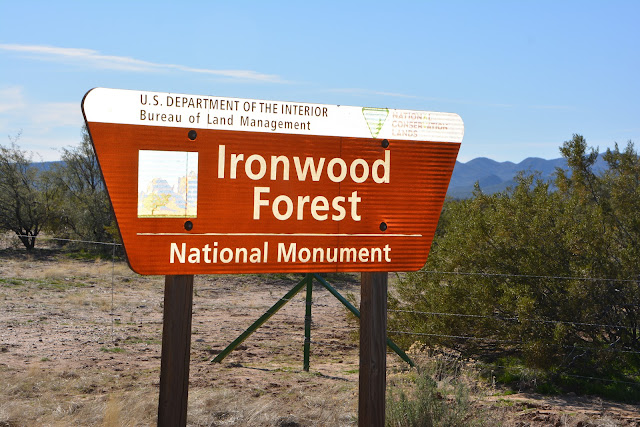After lunch on Sunday, we drove an hour west of Tucson, through Saguaro National Park West, and then on rutted dirt roads to Ironwood Forest National Monument. We passed through several ranch gates and arrived at a trailhead, with one other vehicle parked there. A second vehicle arrived soon after we did, and we were the only visitors for the afternoon.
Ironwood Forest National Monument was created in 2000, covering 188,619 acres. There is a significant concentration of ironwood trees in the monument. The desert ironwood is a long-lived tree, with some specimens living more than 800 years. Within the monument site, there are more than 200 Hohokam and Paleo-Indian archaeological sites, dating between 600 and 1450 AD.
I read about Hohokam petroglyphs on the site before we went. We found the greatest concentration on Cocoraque Butte, on top, in piles of boulders. There were more on the butte directly west, also etched on boulders. We talked to one of the other six visitors and he told us of hiking through hundreds of scattered pottery shards, just before he saw us. We had a terrific time, under clear skies, and 60's temperature. It was a perfect day to hike!
Ironwood Forest National Monument was created in 2000, covering 188,619 acres. There is a significant concentration of ironwood trees in the monument. The desert ironwood is a long-lived tree, with some specimens living more than 800 years. Within the monument site, there are more than 200 Hohokam and Paleo-Indian archaeological sites, dating between 600 and 1450 AD.
I read about Hohokam petroglyphs on the site before we went. We found the greatest concentration on Cocoraque Butte, on top, in piles of boulders. There were more on the butte directly west, also etched on boulders. We talked to one of the other six visitors and he told us of hiking through hundreds of scattered pottery shards, just before he saw us. We had a terrific time, under clear skies, and 60's temperature. It was a perfect day to hike!




















